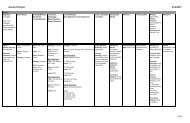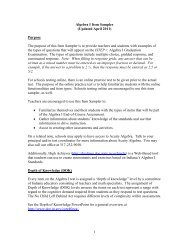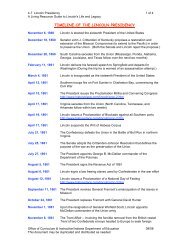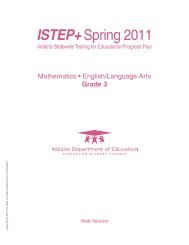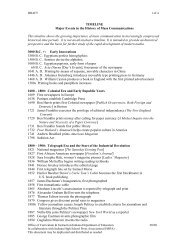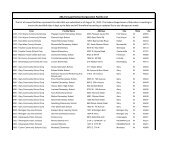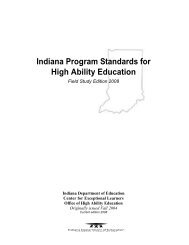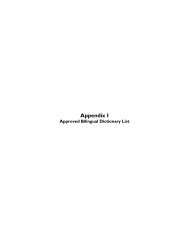Early Childhood ISTAR-KR Assessment Handbook - Indiana ...
Early Childhood ISTAR-KR Assessment Handbook - Indiana ...
Early Childhood ISTAR-KR Assessment Handbook - Indiana ...
Create successful ePaper yourself
Turn your PDF publications into a flip-book with our unique Google optimized e-Paper software.
� What Children Might Demonstrate: First Steps, Making Progress, Accomplishing the<br />
Standard<br />
Ms. Gronlund’s system begins with a new way of thinking and seeing work with children:<br />
In order to meet the standard of _________, we must do/provide/encourage this activity.<br />
Intentional lesson planning is the next step to this new way of thinking and seeing, and includes<br />
the standards in the lesson or activity plan, (see example in Appendix J, page 54). This method<br />
reminds the teacher that assessment and curriculum planning must go hand in hand. As teachers<br />
observe children to learn about progress toward learning expectations, they are naturally making<br />
decisions about what to do next.<br />
General Curriculum Modification/Adaptation Principles<br />
In high-quality early childhood classrooms, it is common to see activities and materials that will<br />
meet the needs of many children with or without disabilities. However, the needs of a specific<br />
child can result in specific adaptations or modifications for an activity, routine, or in the<br />
environment. The purpose of adaptations is to promote a child’s successful participation in<br />
everyday routines and activities. When we design an adaptation of an activity or routine for a<br />
specific need of a child, we have increased the potential for true learning to take place. Any child<br />
must be actively engaged in the learning experience to acquire new skills.<br />
Common categories of general adaptations:<br />
• Adapt Environment: room set-up, or adapt/select equipment<br />
• Adapt Activity or Routine<br />
• Adapt Materials<br />
• Adapt Requirements or Instruction<br />
• Provide Instruction<br />
It is important to reiterate that the goal of any adaptation is to ensure the highest level of child<br />
participation with the least amount of assistance as possible. When teachers design appropriate<br />
adaptations for a particular child’s needs, it is helpful to consider the collaborative potential of<br />
their instructional community, e.g., teachers, assistant teachers, therapy providers, and family<br />
members. Thoughtful decision-making is at the core of creative and successful adaptations.<br />
A helpful structure for decision-making taken from CARA’s Kit, 2007:<br />
1. Identify the child’s needs by evaluating his/her performance: What is actually happening<br />
in particular routines and activities?<br />
i. Language & Literacy Activities<br />
ii. Group Meeting/Circle Meeting<br />
iii. Table Top Activities (manipulatives, puzzles, pre-writing)<br />
iv. Active Learning & Movement Activities<br />
v. Routine Transitions Between Activities<br />
vi. Arrival & Departure<br />
vii. Community Outings (walks, field trips)<br />
29



